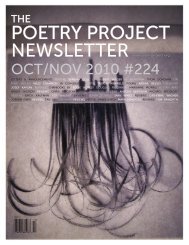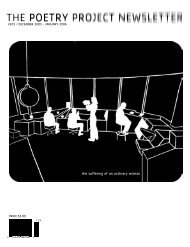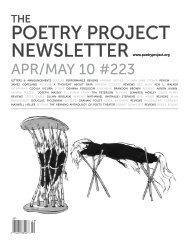You also want an ePaper? Increase the reach of your titles
YUMPU automatically turns print PDFs into web optimized ePapers that Google loves.
26 FEB/MAR 10 #222<br />
BOOK REVIEWS<br />
Hejinian. Emma says (again): “Pull over<br />
to gawk at the swirls of evergreen trees<br />
dipped in the brightest autumn hues.” <strong>Poetry</strong><br />
is the language of experience in a moment/<br />
written. In the journey, the text, the “details<br />
may have been lost in the instability<br />
of the dream terrain or in one’s own forgetfulness”<br />
(Hejinian). Yet “forgetfulness” is<br />
a mode to forge new byways—to push<br />
against the tired concepts and forge new<br />
cartographies.<br />
***<br />
In a language newly gesturing, what is the<br />
cartographer’s best map? This book asks,<br />
in Nona’s introduction: “What do twentysomething<br />
women care about? What are<br />
their hopes, worries, and ambitions?”<br />
Such navigational questions open<br />
Girldrive but do not cease as the book<br />
progresses. Nona describes a project<br />
dreamed up by the two graduating college<br />
seniors over a spring-break brunch<br />
in New York, ordering the proverbial “eggs<br />
and Bloody Mary’s” (GD xii, xi). <strong>The</strong> result<br />
is “poetry”—but without genre or traditions<br />
of “poetic form.” At first glance, the book’s<br />
glossy full-color cover and pages are slick<br />
enough to seem as if a high-production<br />
scrapbook made by these sophisticated<br />
“twenty-somethings” who possess a good<br />
camera and a Photoshop application. Yet<br />
the book is so much more. A conceptual<br />
“poetic” work, Girldrive is a multi-media<br />
ensemble and “inter-genre” manifesto as<br />
well as memoire, art photography, and interview<br />
print journalism. And what makes<br />
the book truly innovative is not just this porous<br />
format but the brave interviews with<br />
young women, most relative strangers to<br />
the authors, who replicate what appear<br />
to be American young women’s doubts,<br />
fears, cultural condemnations and hopes<br />
and innovations on a feminist “movement,”<br />
it turns out, that is still moving—<br />
moving beyond that of their Baby Boom<br />
mothers (like myself).<br />
<strong>The</strong>re is Krystal of Flint, Michigan, who<br />
declares in her interview: “I witnessed<br />
my mom go through a lot of chaos and<br />
confusion and abuse, and I remember<br />
thinking I couldn’t be that way” (GD 15).<br />
<strong>The</strong>re is the Chicana feminist Martha Cotera<br />
and her daughter Maria of Ypsilanti.<br />
<strong>The</strong>re is Shelby of Jackson Hole, who lives<br />
in “’the “equality state,” the first state to<br />
grant women’s suffrage (Wyoming), and<br />
yet it is a state that still coddles the menfolk<br />
who “‘drive trucks, shoot guns, and<br />
marry women for the cooking’” (GD 24).<br />
In Sioux Falls we go to the Top Hat dive<br />
bar for cheap drinks, meeting a single<br />
welfare mom who rejects both the falsity<br />
of knowledge through a college degree<br />
and a bartending job (“‘You’re a vagina<br />
behind the bar.’”) What are the options for<br />
young women, this book, this road trip,<br />
makes us ask?<br />
<strong>The</strong>re are no answers in Girldrive to that<br />
question. Yet there is Jerlina, a Berkeley<br />
doctoral student of the African Diaspora,<br />
and Starhawk, a pagan spokeswoman<br />
and ecofeminist. <strong>The</strong>y show us new road<br />
maps, new directions. <strong>The</strong>re is Joanna<br />
Frueh, an art historian in Tucson who<br />
makes the “breezy admission that sex<br />
is central all through a woman’s life, not<br />
just her youth” (GD 77), dispelling age<br />
bias against women. And there is Szoke,<br />
a New Yorker transplanted to Denver, a<br />
waitress who admits: “Male waiters are<br />
more respected. <strong>The</strong>re are always going<br />
to be those people who get off on the<br />
idea that a woman is serving them.”<br />
In Tulsa, we meet Melody and Mana;<br />
in Austin we go to a burlesque show with<br />
Florinda (“‘playwright, artist, activist, singer<br />
educator’”—and all of 29). A photograph<br />
of the fulsome Stephanie in front of<br />
a red curtain stares back upon our gaze.<br />
So does the pink-dyed head of Cait, the<br />
buxom pose of Raine (in appropriate<br />
burlesque costume). And Elsa, Laurie,<br />
Carmen, Erika—we see them sit in rockers<br />
and in beauty-shop hair-dryer chairs;<br />
we see them standing in front of activist<br />
bulletin boards and in kitchens. In Baton<br />
Rouge we meet the “street urchins” Charlotte<br />
and Angie. Says the latter: “I don’t<br />
know if I’m a feminist. I believe in equality.”<br />
<strong>The</strong>se mostly younger women generally<br />
report that they still feel silenced<br />
and objectified by male counterparts in<br />
their various regions of the U.S. <strong>The</strong>y are<br />
professional women, working-class women,<br />
college women, unemployed women.<br />
<strong>The</strong>se articulate women—particularly, women<br />
of color are well-represented in this<br />
volume—state that they are betrayed by<br />
the falsity of American democratic culture.<br />
Yet they show their knowledge and their<br />
strength.<br />
***<br />
I don’t know what “feminism” is—<br />
although I teach something called “feminist<br />
theory.” Every semester at City College<br />
(CUNY) in these so-called “women’s studies”<br />
classes, I ask my students a question<br />
I have no answer for: What is feminism?<br />
Of course, my students don’t know the<br />
answer either. But a good conversation<br />
usually ensues. Girldrive is a porous text<br />
that makes us ask that question again<br />
and again, in the way Hejinian describes<br />
poetic language itself—as a mode of “inquiry.”<br />
Frankly, I don’t know what “poetry”<br />
is either—except that I like what I perceive<br />
to be its “strangeness.”<br />
For all the questions it raises about<br />
feminism and art, Girldrive is clearly an ambitious<br />
mutational amalgamation of both.<br />
It is a road book and a textbook-primer<br />
for feminists—and not just the feminists<br />
of the present generation, but of the future<br />
and past. Thanks to Nona’s startling courage<br />
in seeing this unusual book finished, Emma’s<br />
shade is with us. Both “girl-drivers”<br />
lead us not toward a momentary destructive<br />
path, that of the youthful tragic,<br />
but toward something inspiring, the future.<br />
Laura Hinton is a Professor of English at the City<br />
College of New York, where she teaches feminist<br />
theory and contemporary women’s poetics, film and<br />
media culture. She is the author of the poetry book<br />
Sisyphus My Love (BlazeVox), among others.

















